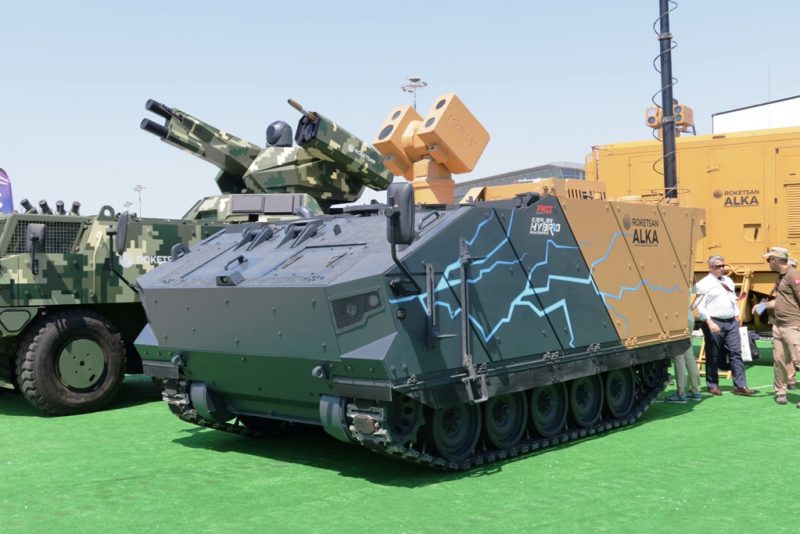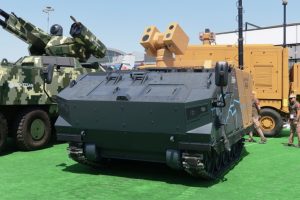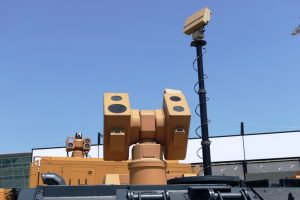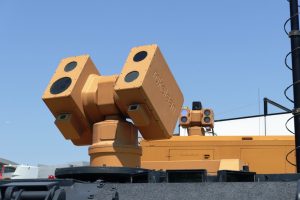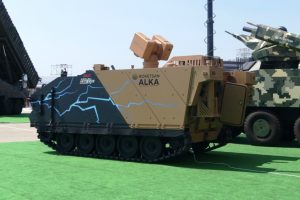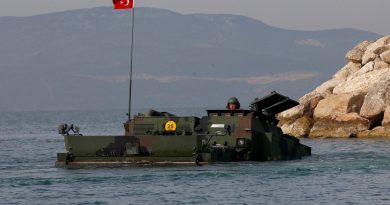IDEF 2025 – FNSS and Roketsan join to present a self-propelled armoured C-UAS system
At IDEF 2025 FNSS and Roketsan unveiled a self-propelled C-UAS proposal that is based on the Kaplan Hybrid platform from FNSS and the Alka directed energy weapon system (DEWS) by Roketsan, the technology demonstrator being exhibited on the apron of the “Ataturk” airport, which this year hosted several major land systems and aircraft
At IDEF 2023 FNSS announced its hybrid propulsion roadmap, unveiling its Kaplan hybrid tracked armoured personnel carrier. At that time the vehicle had performed a couple of mobility tests, and was considered a technology demonstrator. What was on stage at IDEF 2025 was a much more mature system. “Through these last two years our prototype development processes continued and now we have successfully fulfilled most of the mobility tests. We also have spared some resources on the weapon system integration,” Semih Dağdeviren, FNSS’ Project Manager Hybrid Vehicles told EDR On-Line.
What could be seen at IDEF 2025, on the apron of the “Ataturk” airport, was not yet a fully integrated weapon system, as integration work is still ongoing. “We invested some time on this weapon system integration to demonstrate the benefits of hybridization in such an armoured vehicle. We now have a demo vehicle that is not yet fully operating with the weapon systems, but our goal is to have a fully functioning hybrid vehicle with a directed energy weapon system [DEWS] by the end of the year,” Mr. Dağdeviren added, the weapon system being Roketsan Alka.
Before switching to the weapon system let us see what has been the evolution of the FNSS solution.
“ Two years ago the vehicle was functioning in fully electric mode. Now it can also work in the hybrid mode. In the last two years we developed the control software as well as the generator. The vehicle is now capable to reach 65 km/h, two years ago speed was limited for safety considerations, and thanks to the generator we can now export up to 220 kW of power,” the Project Manager Hybrid Vehicles explained, adding that the system was also optimised to reduce fuel consumption.
According to information provided by Roketsan, the Alka DEWS has an operational range against drones of 1.1 km at 2.5 kW output, 1.6 km at 5 kW and 2.2 km at 10 kW. Detection is provided by a radar, which is installed on another vehicle, the fire control system being able to follow up to 100 different targets at the same time, day and night.
With a maximum output of 10 kW, consumption might be three-four times more, considering all ancillaries, however this is well within the limits of the hybrid vehicle export power. “We talked to Roketsan and we should be able to operate the weapon system for around one hour without running the generator, exploiting energy stored in batteries, which reduces vibrations as well as thermal signature,” Mr. Dağdeviren told us.
Not running generators is key in ensuring maximum accuracy, as it reduces vibrations, maxing the system more stable; DEWS need not only to precisely focus the laser beam onto the target, but also to maintain it on the target for the needed time to discharge the amount of energy sufficient to disrupt the drone or its electronics, therefore a stable platform increases the kill probability, reducing the single engagement time, and increasing the number of available “rounds”, a vital issue when coping with swarms of drones.
This is one of the issues that might limit fire-on-the-move capabilities, and for the time being the FNSS-Roketsan team is planning static firing tests, which are forecasted in early 2026. These will also reveal the reloading speed, hence the “rate of fire” of the system.
Coming to the Alka, Roketsan developed a networked DEWS that uses laser effectors as well as radiofrequency systems, the latter not installed on the FNSS Kaplan Hybrid. The system can be deployed with multiple effectors, sensors and a command post to defend a forward operating base, or kept as a stand-alone self-propelled system, such as the one described in this article. On land the Alka aims at neutralising drones, loitering munition, mini/micro UAVs, improvised explosive devices. It is also being considered for naval use, where it would deal with floating mines and unmanned surface vessels (USVs).
Photos by P. Valpolini

